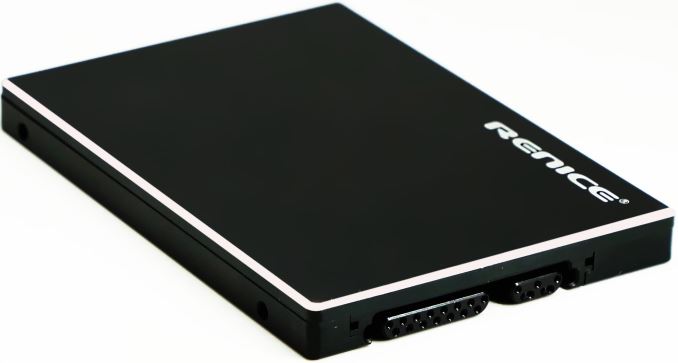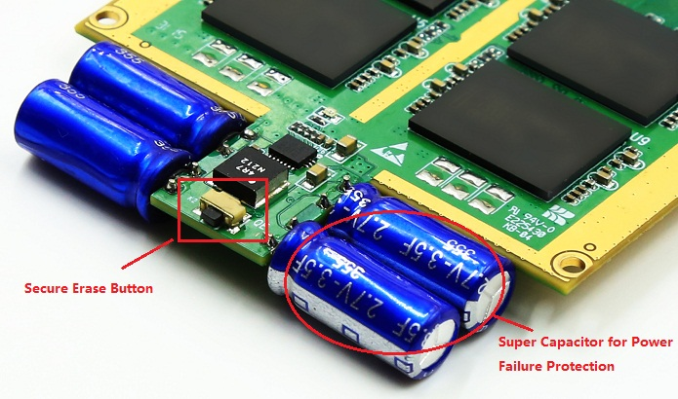Renice Announces X9 Military-Grade Rugged SSDs with R-SATA Connectors
by Anton Shilov on March 25, 2016 12:00 PM EST
Shenzhen Renice Technology, a little-known maker of special-purpose SSDs from China, has introduced its new family of drives designed for military and rugged applications. What makes these new drives notable is that they are designed to withstand harsh environments, utilizing special R-SATA connectors as well as custom controllers. On the NAND side the drives are build around SLC, MLC or pseudo-SLC NAND flash memory to provide the required balance between endurance, price and performance.
The Renice X9 R-SATA SSDs are powered by the company’s own controller, the RS3502-IT, as well as SLC or MLC NAND flash memory from undisclosed manufacturers. The drives are made in accordance with the MIL-STD-810F spec to withstand harsh environments and poor handling, and feature integrated power failure protection as well as 256-bit AES encryption with several secure erase functions (both software and hardware). The Renice X9 SSDs use the company’s proprietary 15-pin R-SATA connectors as well as special 7-pin SATA power ports, which limits compatibility of the drives to applications that feature the same connectors.
The SLC-based X9 R-SATA drives are offered in 128 GB – 1 TB configurations, whereas MLC-powered SSDs are available with 256 GB – 2 TB capacities. If required, Renice can use MLC NAND in pseudo-SLC mode in order to provide higher endurance and performance at a predictable cost. The Renice X9 comes in 2.5” form-factor with 7, 9 or 15 mm thickness, depending on the exact capacity configuration.
The manufacturer claims that the X9 SSDs have maximum sequential read speed of up to 530 MB/s and maximum sequential write speed of up to 500 MB/s along with 0.1 ms access time. The company does not specify random read/write performance of the drives, but claims that it is “excellent”. Keeping in mind that X9 SSDs can use different types of NAND flash memory and come in various configurations, random I/O performance of different models is likely to vary greatly.
| X9 2.5" R-SATA SSD Specifications | ||
| Renice X9 | ||
| Capacity | 128 GB - 1 TB (SLC) 256 GB - 2 TB (MLC) |
|
| Type of NAND | SLC MLC pseudo-SLC |
|
| Controller | RS3502-IT | |
| Interface | R-SATA (proprietary) 6 Gbps | |
| Form-Factor | 2.5" 7/9/15 mm | |
| Maximum sequential read/write | 530/500 MB/s | |
| DRAM Cache | Supported | |
| AES | 256-bit | |
| Overvoltage Protection | + | |
| Power Loss Protection | Yes, features four supercapacitors | |
| Secure Erase | Hardware and Software | |
| MTBF | 4 Million Hours | |
| ECC | 80 bits at 1024 | |
| Vibration | 16 G (10 - 2000 Hz) | |
| Shock | 1500 G at 0.5 ms half sine wave | |
| Humidity | 5 - 95% | |
| Operating Temperatures | -40ºC ~ +85ºC (industrial) -55ºC ~ +120ºC |
|
| Power Consumption | 10 W (2 TB) | |
With regards to reliability, the Renice X9 drives boast a MTBF of over four million hours, while their physical tolerance is rated for 16.4G (10 – 2000 Hz) sustained vibration and 1500G (@ 0.5 ms half sine wave) shock, something that typical drives simply do not offer (Intel's DC S3710 SSD, by comparison, can tolerate 2.17 G operating vibration and can survive 1000 G shock). The X9 SSDs are designed for operating temperatures ranging from -40°C to +85°C (industrial-grade) or even -55°C to+125°C (military-grade), which is in line with other SSDs for extreme environments (such as those from Amtron or Foremay). Meanwhile, datacenter drives like the DC S3710 can operate when its temperature is between 0ºC and +70ºC.
Given that Renice is a Shenzhen-based company, it is admittedly unlikely that the X9 SSDs will be used in military or defence applications outside of China. Nonetheless, since the drives are designed to withstand harsh environments in general, the X9 SSDs can be used in aerospace, industrial, transportation, outdoor storage and other systems that are subject to extreme temperatures, severe vibrations and other types of harsh environments.
Exact pricing of the Renice X9 depends on memory configuration and additional features that the manufacturer may offer (e.g., extended operating temperatures). Typically, rugged drives cost significantly more than typical SSDs.
Source: Renice
















16 Comments
View All Comments
Samus - Sunday, March 27, 2016 - link
I agree. To get solid ceramic caps in this capacity would be prohibitively expensive, if they are even available...they are quite large for their charge capacity as well because the bulk of their size is insulation (which is why they tolerate temp extremes) but electrolytic caps are pretty stable for just about any application on Earth. The other benefit of solid caps is ripple suppression which is irrelevant for this application because we are going to assume the power supply is equally as rugged as the SSD.thope - Saturday, March 26, 2016 - link
The caps might double as some sort of emergency destructive erase. The placement of the button and the application for which the drive seems to be designed fits the narrative better.Anato - Saturday, March 26, 2016 - link
Even cased I doubt those caps will stick there in "16.4G (10 – 2000 Hz) sustained vibration".Lord of the Bored - Saturday, March 26, 2016 - link
Man, those connectors. I want to see them replace the official connectors as standard....
If only the SATA-IO had considered the slightest possibility of abuse when designing the current connectors. Flimsiest parts in my entire PC are SATA connectors.
bigboxes - Saturday, March 26, 2016 - link
YesSamus - Monday, March 28, 2016 - link
Those are really nice connectors. I don't see why everything has gotten so fragile over the years. USB connectors are pretty robust but the sockets are not. SATA is a joke, I see motherboards with broken connections (often just cracked, still working) in the shop quite often, especially on Dell's and HP's because they use locking SATA cables and people never notice the spring latch. I've seen people rip DisplayPort connectors out the side of their laptops because they didn't even notice the spring latch! But the alternative is HDMI, which literally just falls out over time on connections that face down (which is why most displays, particularly TV's, have them facing sideways.It's a start contract to the 80's and 90's with ribbon cables that were sometimes SO jammed in you'd rip the cable or crack the plastic compressor strip removing them. Starting with ZIF sockets there was this trend toward more user friendliness at the cost of component integrity/lifespan. And the annoying this is the manufactures/standards agencies know the initial specs are weak, which is why almost every standard since, and including, USB, has had a soft recall of connectors, sockets, or cables, shortly after their initial public adoption. In the case of SATA, it started with SATA (1.5Gbps) cables that inherently couldn't communicate at 3Gbps when SATA2 was introduced, leading to a lot of data corruption. With the SATA3 (6Gbps) spec there was a integrity algorithm implemented during init that would downgrade the connection speed if the cable wasn't up to snuff (this init detection wasn't implemented for SATA2)
No need to go into detail on Thunderbolt, we all know it's vast shortcomings, which are now finally being sorted with USB-C. Ironically, IEEE1394 that it spiritually succeeds was one of the few connection standards that was very robust from the get-go.